
Download
in PDF Format
Peanuts
put Suffolk, Va., on the map, and just as they have for centuries,
agricultural fields still stretch for miles across the city's rural
landscape.
But the 360-square-mile city is changing
fast.
|

Mr.
Peanut reflects Suffolk's rich history with the peanut industry,
particularly Planters Peanuts. |
In Suffolk, now one of the
fastest-growing cities on the East Coast and the second fastest-growing
city in Virginia, commercial businesses and upscale subdivisions are
sprouting as quickly as crops in the fields.
Suffolk�s rich history can be traced
back almost 400 years, when the Nansemond Indians peacefully roamed the
shores and woodlands of the area and early Jamestown colonists traded with
the tribe.
In the early 1700s, the English began to
settle in the area and in 1742, the town of Suffolk � named after Gov.
William Gooch�s home in Suffolk County, England � was formally born.
On more than one occasion throughout
history, the city�s future was jeopardized. The British burned Suffolk
in 1779, and for several years during the Civil War, the Union held the
town under siege.
But each time, the residents and the
town itself came back stronger, making way for the city�s incorporation
in 1910.
Suffolk�s claim to international fame
came in 1912, when young Italian immigrant Amedeo Obici moved from
Pennsylvania to Suffolk and opened Planters Nut and Chocolate Co. A couple
of years later, a 14-year-boy won a drawing contest with his image of Mr.
Peanut � the company�s legendary icon.
|
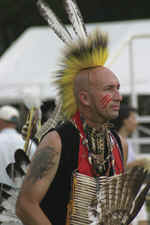
Suffolk's
first inhabitants were members of the Nansemond Indian tribe, who
had made their homes along the banks of the Nansemond River by the
time English settlers came in the early 1600s. Every August, the
tribe holds a powwow at its ancient tribal grounds, drawing
thousands of visitors from across Virginia. The tribe also
operates a Nansemond museum in Chuckatuck. |
Today, passersby through Suffolk are
greeted by a life-sized Mr. Peanut in downtown�s Character Corner.
Suffolk, as we know it today, was born
out of the 1974 marriage of the old city of Suffolk, trapped within its
2-plus-square-mile city limits, and the rural Nansemond County that hugged
the city on every side.
The merger, in one fell swoop, nearly
quadrupled the city�s population from 12,555 to 45,000 in 1974. Suffolk,
after a growth rate upwards of 20 percent during the 1990s, today has
nearly 71,000 residents.
Big-City Perks,
Small-Town Flavor
Residents are
increasingly able to reap the amenities of a big city, while at the same
time retain the affordability, flavor and character of a small town.
|
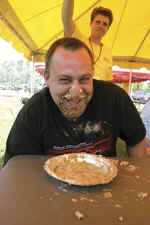
The
pie-eating contest is always a favorite and certainly one of the
tastiest activities at the Suffolk Peanut Festival. |
�Right now, people
are finding they can get more house for the money in Suffolk than in other
Hampton Roads cities,� says developer Mickey Garcia, 34, of Suffolk.
�At the same time, they are finding a better quality of life here.�
Neighboring Hampton
Roads cities grew up too fast and were unprepared for the deluge of people
and services they required, Garcia says. Though Suffolk goes through
occasional growing pains, it still manages to keep up with the development
and infrastructure needs far better than its counterparts.
Elizabeth McCoury,
the city�s downtown development coordinator, agrees.
�Quality of life is
a huge issue � the level of services, libraries, the amount of open
space, the roads, schools,� she says. �There is diversity in
Suffolk�s housing stock.
�People can find
the type of housing they want in Suffolk, whether it is a downtown loft or
a planned development with sidewalks or a small farm.�
|
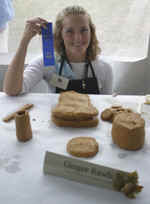
Contestants
participating in the peanut-butter sculpting contest, a tradition
at the Suffolk Peanut Fest, are encouraged to be imaginative. Last
year's blue-ribbon winner Ginger Rowls sculpted a favorite snack -
a peanut butter and jelly sandwich and everything needed to make
it. |
Developers like
Garcia, working in concert with city officials, are focused on
rejuvenating the city�s downtown community.
Several cornerstones
to the downtown revitalization are now underway, such as construction of a
$22 million Hilton Garden Inn and Suffolk Conference Center, and the $15.5
million restoration of the former Suffolk High School into a cultural arts
center.
Located in the heart
of downtown Suffolk, the high school built in 1922 was vacated in 1990 by
the school system. More than a decade later, a group of residents
spearheaded a private fund-raising campaign and won the local
government�s support to help fund the center.
The Suffolk Center
for Cultural Arts will have something for everyone: performing-arts
classes, artist studios, and an auditorium for guest performances and the
like, says Betsy Brothers, the center�s executive director.
�That cultural arts
center can make or break downtown,� Garcia says. �Done right, it is
going to have a phenomenal impact on Suffolk.
�The cultural arts
center is going to be the glue that holds downtown together,� he
continues. �It�s going to bring outsiders into Suffolk. It�s going
to bring a new set of eyes in to look at a new Suffolk.�
That�s also the
goal of Suffolk�s new tourism department, which is focusing efforts on
the city�s rich Civil War history and its close proximity to the Great
Dismal Swamp Wildlife refuge.
High-Tech Growth
Exploding
|
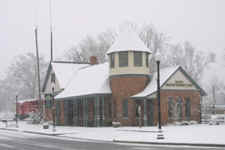
The
Suffolk-Nansemond Historical Society restored the circa-1885 train
station in the heartof downtown Suffolk about five years ago.
Today, the society operates the Suffolk Seaboard Train Station and
Railroad Museum, one of a growing number of museums and cultural
sites in the community. |
In the northern
section of the city, particularly along the U.S. 17 and Interstate 664
corridor, high-tech growth and development are exploding onto the scene.
The 1994 opening of
the U.S. Joint Forces Command Joint Warfighting and Experimentation
Center, where the military conducts war games around the world by
computer, set the stage for the high-tech growth now being seen in the
area.
Three years later,
city leaders successfully wooed a second high-tech company: the Virginia
Modeling, Analysis and Simulation Center. Today, Lockheed Martin is
building a $31 million, 50,000-square-foot global vision integration
center in the northern part of the Suffolk community.
|
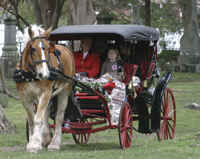
With
Suffolk capturing the attention of a growing number of Civil War
buffs, the city's tourism department and other organizations
sponsor occasional events in Cedar Hill Cemetery. The downtown
Suffolk cemetery, though still in use today, has headstones dating
back to the Civil War era. |
Tom O�Grady, the
city�s director of economic development, believes those three companies
have sealed Suffolk�s place in the future of high-tech industry.
�When people think
of a developing technology corridor, they usually think of Newport News
and NASA,� he says. �Now they can add Suffolk to that list.�
But despite the
expanding high-technology industry and new folks moving in, Mike Williams
is hopeful Suffolk won�t lose what makes it such a special place:
friendly faces and cheerful attitudes.
�I think the pace
is a little slower and that things are a little more laid back here than
in other bigger cities,� says Williams, owner of Baron�s Pub, which
opened in downtown Suffolk last year. �This is an up-and-coming place,
and we were glad to get in on the ground level.�
Mayor Bobby Ralph and
McCoury agree that its people make Suffolk what it is.
|
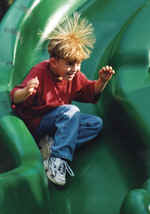
Kent
Brooks enjoys an electrifying twirl down the slide at one of the
many city parks scattered throughout Suffolk. |
�I hear a lot of
people talking about how nice everyone is in Suffolk,� says McCoury.
�I think people are friendlier here because they don�t get quite as
rushed and harried as they do in more metropolitan places.�
Suffolk does have a
very �hospitable, Southern atmosphere,� adds Ralph.
�We
make people feel welcome here,� he says. �We make them want to join us
rather than be apart from us.�